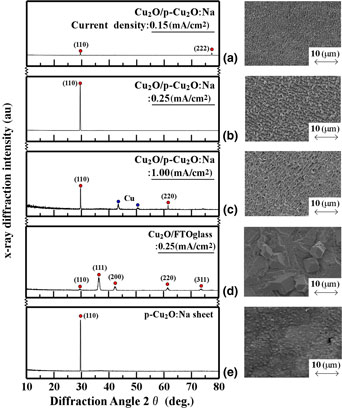Crossref Citations
This article has been cited by the following publications. This list is generated based on data provided by
Crossref.
Brandt, I. S.
Tumelero, M. A.
Pelegrini, S.
Zangari, G.
and
Pasa, A. A.
2017.
Electrodeposition of Cu2O: growth, properties, and applications.
Journal of Solid State Electrochemistry,
Vol. 21,
Issue. 7,
p.
1999.
Yeh, H.H.
Wen, M.C.
Chang, L.
Ploog, K.H.
and
Chou, M.M.C.
2019.
Epitaxial growth of Cu2O on Cu substrate – A combinatorial substrate approach.
Journal of Crystal Growth,
Vol. 512,
Issue. ,
p.
124.
Li, Changli
He, Jingfu
Xiao, Yequan
Li, Yanbo
and
Delaunay, Jean-Jacques
2020.
Earth-abundant Cu-based metal oxide photocathodes for photoelectrochemical water splitting.
Energy & Environmental Science,
Vol. 13,
Issue. 10,
p.
3269.
Jayathilaka, Charith
Kumara, Loku Singgappulige Rosantha
Ohara, Koji
Song, Chulho
Kohara, Shinji
Sakata, Osami
Siripala, Withana
and
Jayanetti, Sumedha
2020.
Enhancement of Solar Cell Performance of Electrodeposited Ti/n-Cu2O/p-Cu2O/Au Homojunction Solar Cells by Interface and Surface Modification.
Crystals,
Vol. 10,
Issue. 7,
p.
609.
Zhou, Lite
Bainglass, Edan
Masroor, Maryam
Giri, Binod
Li, Guangjiang
Carl, Alexander
Grimm, Ronald L.
Huda, Muhammad N.
Titova, Lyubov V.
and
Rao, Pratap M.
2021.
Synthesis and optoelectronic properties of a promising quaternary metal oxide light absorber CuBiW2O8.
Journal of Materials Chemistry A,
Vol. 9,
Issue. 3,
p.
1643.
Naceur, Khadidja
Tibermacine, Toufik
Mehiri, Fateh
Boumaaraf, Rami
Labed, Madani
Meftah, Afak
Meftah, Amjad
and
Sengouga, Nouredine
2021.
Study and optimization of Cu2O/AZO hetero-junction solar cell with different buffer layers.
Optical Materials,
Vol. 115,
Issue. ,
p.
111060.
Lakshmanan, A.
Alex, Zachariah C.
and
Meher, S.R.
2022.
Recent advances in cuprous oxide thin film based photovoltaics.
Materials Today Sustainability,
Vol. 20,
Issue. ,
p.
100244.
Sun, Bin
Chen, Hao
Yan, Kang
and
Feng, Xiao-Dong
2022.
Numerical investigation of the Cu2O solar cell with double electron transport layers and a hole transport layer.
Optical Materials,
Vol. 131,
Issue. ,
p.
112642.
Cheng, Jinshui
Wu, Linxiao
and
Luo, Jingshan
2022.
Cuprous oxide photocathodes for solar water splitting.
Chemical Physics Reviews,
Vol. 3,
Issue. 3,
Yu, Xiaojiao
Zhao, Chen
Liu, Zongbin
Wei, Yuchen
Yang, Meng
Guo, Biqi
and
Niu, Jinfen
2023.
Preparation of ZnO/Cu2O Composite Particles and Its Degradation of Ciprofloxacin: Analysis of Degradation Performance and Active Species.
Integrated Ferroelectrics,
Vol. 236,
Issue. 1,
p.
96.
Chen, Sinuo
Wang, Lichun
Zhou, Chunlan
and
Yang, Jinli
2023.
A review of Cu2O solar cell.
Journal of Renewable and Sustainable Energy,
Vol. 15,
Issue. 6,
Pan, Linfeng
Dai, Linjie
Burton, Oliver J.
Chen, Lu
Andrei, Virgil
Zhang, Youcheng
Ren, Dan
Cheng, Jinshui
Wu, Linxiao
Frohna, Kyle
Abfalterer, Anna
Yang, Terry Chien-Jen
Niu, Wenzhe
Xia, Meng
Hofmann, Stephan
Dyson, Paul J.
Reisner, Erwin
Sirringhaus, Henning
Luo, Jingshan
Hagfeldt, Anders
Grätzel, Michael
and
Stranks, Samuel D.
2024.
High carrier mobility along the [111] orientation in Cu2O photoelectrodes.
Nature,
Vol. 628,
Issue. 8009,
p.
765.






